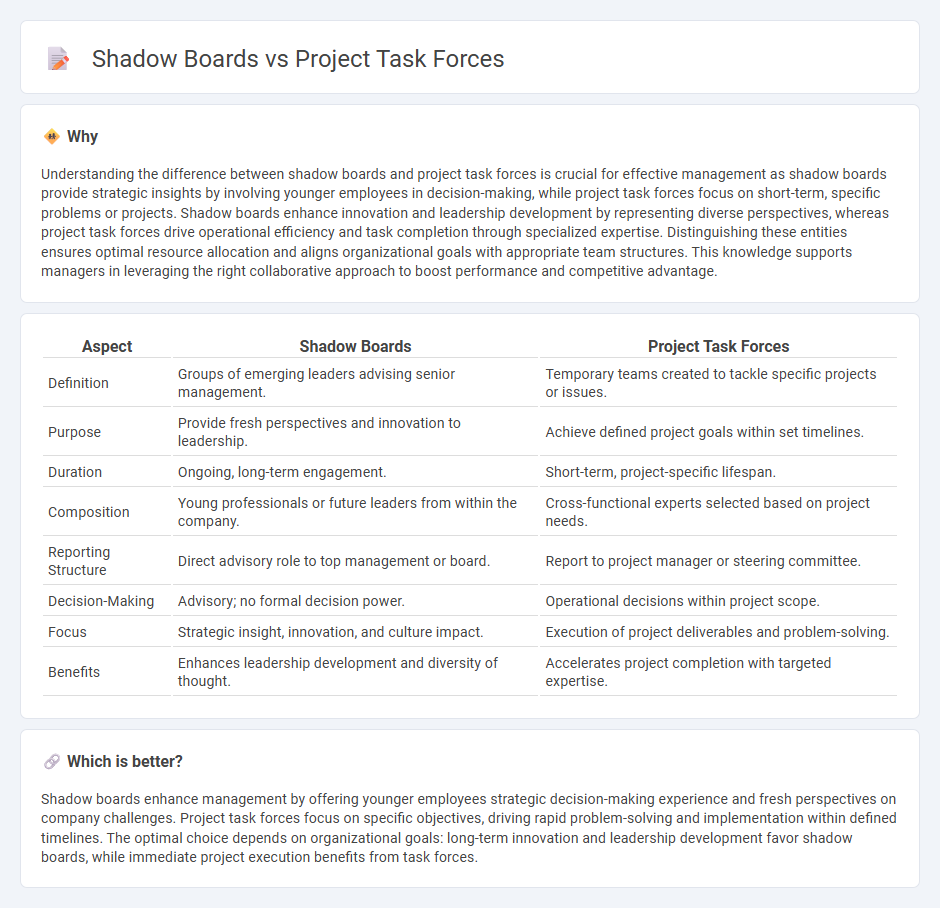
Shadow boards consist of diverse, cross-generational employees who advise executives on strategic decisions, ensuring fresh perspectives and enhanced innovation within the organization. Project task forces are specialized teams assembled temporarily to address specific business challenges or drive critical initiatives, focusing on rapid problem-solving and efficient execution. Explore the distinct roles and benefits of shadow boards and project task forces to optimize management strategies in your company.
Why it is important
Understanding the difference between shadow boards and project task forces is crucial for effective management as shadow boards provide strategic insights by involving younger employees in decision-making, while project task forces focus on short-term, specific problems or projects. Shadow boards enhance innovation and leadership development by representing diverse perspectives, whereas project task forces drive operational efficiency and task completion through specialized expertise. Distinguishing these entities ensures optimal resource allocation and aligns organizational goals with appropriate team structures. This knowledge supports managers in leveraging the right collaborative approach to boost performance and competitive advantage.
Comparison Table
| Aspect | Shadow Boards | Project Task Forces |
|---|---|---|
| Definition | Groups of emerging leaders advising senior management. | Temporary teams created to tackle specific projects or issues. |
| Purpose | Provide fresh perspectives and innovation to leadership. | Achieve defined project goals within set timelines. |
| Duration | Ongoing, long-term engagement. | Short-term, project-specific lifespan. |
| Composition | Young professionals or future leaders from within the company. | Cross-functional experts selected based on project needs. |
| Reporting Structure | Direct advisory role to top management or board. | Report to project manager or steering committee. |
| Decision-Making | Advisory; no formal decision power. | Operational decisions within project scope. |
| Focus | Strategic insight, innovation, and culture impact. | Execution of project deliverables and problem-solving. |
| Benefits | Enhances leadership development and diversity of thought. | Accelerates project completion with targeted expertise. |
Which is better?
Shadow boards enhance management by offering younger employees strategic decision-making experience and fresh perspectives on company challenges. Project task forces focus on specific objectives, driving rapid problem-solving and implementation within defined timelines. The optimal choice depends on organizational goals: long-term innovation and leadership development favor shadow boards, while immediate project execution benefits from task forces.
Connection
Shadow boards and project task forces are connected through their roles in enhancing organizational decision-making and innovation by involving diverse perspectives from different levels of the company. Shadow boards act as advisory groups composed of younger or less experienced employees who provide fresh insights, while project task forces are specialized teams focused on executing specific initiatives or solving targeted problems. Both structures foster collaboration, accelerate problem-solving, and ensure alignment between strategic objectives and operational execution.
Key Terms
Decision-making authority
Project task forces possess defined decision-making authority to execute specific objectives within set deadlines, ensuring focused and timely outcomes. Shadow boards act as advisory panels composed of emerging leaders, influencing strategic decisions without formal authority, fostering innovation and diverse perspectives. Explore how integrating both structures can enhance organizational agility and governance.
Cross-functional collaboration
Project task forces bring together diverse experts temporarily to tackle specific challenges, fostering rapid innovation and problem-solving across departments. Shadow boards consist of emerging leaders who provide fresh perspectives and strategic insights, enhancing long-term decision-making through cross-functional collaboration. Discover how integrating these teams can transform organizational agility and leadership development.
Innovation implementation
Project task forces drive innovation implementation by assembling cross-functional experts to execute targeted initiatives, ensuring rapid problem-solving and efficient resource allocation. Shadow boards, composed of younger employees acting as advisory groups, provide fresh perspectives and strategic insights to influence leadership decisions and foster a culture of continuous innovation. Explore how integrating these structures can accelerate your organization's innovation journey.
Source and External Links
Project teams and task forces - Reinventing Organizations Wiki - Project task forces are often cross-functional groups that emerge organically or are appointed to overcome organizational boundaries; in modern "Teal" organizations, they self-organize without a formal leader and members prioritize participation based on importance, urgency, or enjoyment of the project.
Task Forces - the dark side of project management - hardScrum Blog - Task forces are typically reactive, high-priority groups formed to address troubled or delayed projects, but they can exacerbate broader project management problems and often come at the cost of other projects; shifting to a systemic, transparent, and prioritized approach can reduce these issues.
Types of Teams | Principles of Management - Lumen Learning - A task force is a temporary group of experts formed to analyze or solve specific problems, disbanding after task completion, whereas a project team may be ongoing with a broader task scope.
 dowidth.com
dowidth.com